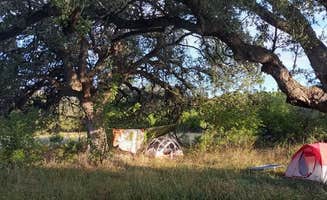Primitive camping near West Lake Hills, Texas requires proper preparation due to the limited facilities and minimal development. The area consists predominantly of backpacking sites accessible via hiking trails around Lake Georgetown, with campsites situated between 2-6 miles from trailheads. Summer temperatures regularly exceed 95°F from June through September, making spring and fall the preferred seasons for most backpackers in this region.
What to do
Wildlife observation: The primitive camping areas around San Gabriel River Trail offer opportunities to spot native Texas wildlife. "The trail circles Lake Georgetown and is 26.2 miles. It passes through forests, grasslands, over some small hills and across a few tributaries," notes camper Troy W.
Shoreline camping: Some backpackers opt to camp near the water rather than at designated sites. At Sawyer Park Primitive Campsites, one visitor reported, "We ended up not following our AllTrails after a fork in the road heading towards the campsite, and were pretty pooped so decided to camp there off Sawyer Campsite Rd. People had clearly used the shore as a campsite before as there was a makeshift fire pit and some cleared areas for tents."
Water activities: For those willing to carry equipment, canoeing provides an alternative access method to some campsites. At Walnut Springs Primitive Campground, a visitor observed, "There was a backpacking group, a group of people who canoed in, and ourselves."
What campers like
Varied terrain: The primitive trails offer diverse landscapes within a relatively compact area. "The trail passes through forests, grasslands, over some small hills and across a few tributaries," according to camper reviews, providing visual variety throughout hikes.
Weekday solitude: For campers seeking isolation, timing makes a significant difference. One reviewer noted, "During the weekdays you may not see a single person," making mid-week visits ideal for those wanting minimal interaction with other backpackers.
Multiple access points: Walnut Springs Primitive Campground offers flexible entry options. "Can be biked in from camp Tejas four miles away or can hike in from Russell Park 2 mi away," reports one camper, allowing visitors to choose their preferred approach based on ability and available time.
What you should know
Water requirements: The combination of heat and limited access points requires careful water planning. "While you may be hiking within site of Lake Georgetown, it is not always convenient to access the water. So carry plenty of water while hiking - at least 2 liters," advises an experienced visitor.
Cat hole necessities: Without maintained facilities, waste disposal requires proper technique. Reviewers consistently mention the need to "dig cat holes" at these sites, and campers should pack appropriate tools for this purpose.
Parking protocols: Communication with park staff helps prevent misunderstandings about vehicle status. "It is good to advise one of the park attendants that you will be hiking or place a note inside your car that you are hiking," suggests one regular camper.
Tips for camping with families
Weather considerations: Thunderstorms can occur with limited warning, but proper site selection minimizes risks. A camper at Walnut Springs reported, "Enjoyed our stay during a thunderstorm under the big trees," suggesting that selecting sites with natural cover provides important protection.
Trail difficulty assessment: The Good Water Trail system includes sections with varying difficulty levels. Consider shorter segments for initial family backpacking trips, as some campsites can be reached with relatively manageable hikes of 2-3 miles.
Weekend planning: Scout troops frequently use these trails for skills development. "On weekends you may encounter scout troops practicing backpacking," notes one regular visitor, which may either provide community or reduce solitude depending on family preferences.
Tips from RVers
Trailhead parking limitations: None of the primitive camping areas permit vehicle access to campsites. RVers must use designated parking areas at trailheads and backpack to primitive sites, making these locations suitable only for RVers comfortable with backpacking from their vehicles.
Base camp alternatives: For RVers wanting to experience the area without backpacking, consider staying at developed campgrounds that offer trail access points, then taking day hikes along segments of the primitive trails.


